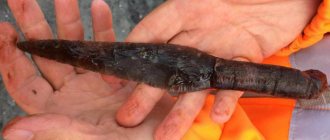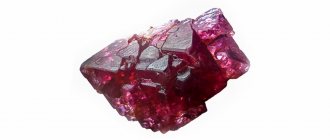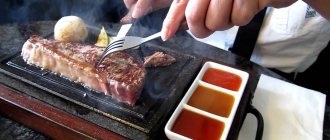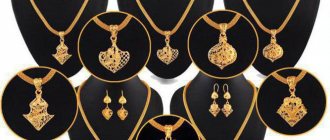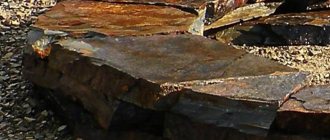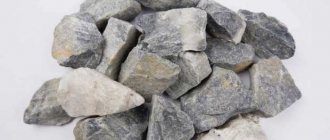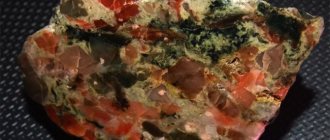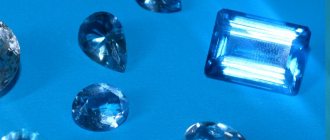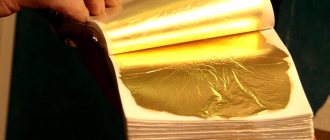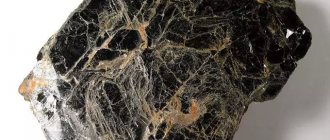Savage, or sandstone, is a stone of natural origin. Essentially it is sand cemented by nature. The variety of types allows it to be used in landscape, decorative finishing, and construction. People have also learned to make analogues. At home, artificial layers are formed, and in factories, flexible stones and hard slabs are made.
Origin of sandstone
Psammolite forms at the bottom of rivers, lakes, seas and oceans. First, rocks are destroyed and turned into psammit - sand, then it is mixed with natural cementing substances, compressed under water pressure over centuries and transformed into a high-strength mineral. This process is called lithization. Also, in some cases, rock cementation occurs without the participation of connecting particles: during mechanical compression (pressure at great depths) or melting in the solid state. The longer sand is compressed, the more mature and durable this building material becomes.
In the case of the formation of minerals at the bottom of the seas and oceans, after millions of years, as a result of the natural movement of the earth’s crust (tectonic activity), the relief rises, the bottom becomes mountains and plains on the surface of the earth, and large deposits of valuable sedimentary rocks become available for mining.
History and origin of the mineral
Psammites (sandy rock) form over centuries at the bottom of deep-sea reservoirs. The savage is formed from fragments of minerals broken off by the current. The accumulation of sand grains sank into unwashed areas, reacted with other substances, and were pressed by the water column. The stone was found in places of dry lakes, seas, rivers, and lagoons.
Made from sandstone:
- Egyptian Sphinx;
- Peter's tomb (Jordan);
- minaret Qutub Minar (1368);
- St. Petersburg house of Kelch (1903);
- Palace of Versailles;
- Parisian buildings (by order of Napoleon III).
Symbols and statues of gods were carved from natural stone; columns and steps were made in temples. A historical complex has been preserved near the village of Busha in the area of the Yampolskoye field.
A pre-Christian rock temple, the city hall, and the remains of a fortress are made of sandstone. The age of some monuments dates back to the 3rd millennium BC.
Sandstone composition
Since this mineral is amazing in its diversity of species, there are many classifications by composition, domestic and foreign, that are scientifically interesting. Here we will focus on indicators useful to the stone processor, designer, builder and, of course, the buyer.
The most common is “savage” made from quartz sand. Less common are rocks made from feldspar, silicon, mica, glauconite and many other minerals. There are even rocks containing semi-precious impurities: tourmaline, opal, zircon, apatite, garnet, hematite, etc. Cement can be used: alumina, kaolin, silica, quartz, feldspar, opal, iron hydroxide (rust), etc.
There are also frequent inclusions of plant or animal nature, for example: wood in rock formed at the bottom of rivers, shells, fossil elements of extinct fish and animals in ocean stone.
Clayey sandstone with nummulites. The fragment includes grains of quartz, feldspar, glauconite, fragments and entire shells of nummulites (1–2 cm). Fine-grained, organogenic structure. The texture is layered.
Based on the amount of minerals in the sand, psammolites are divided into:
- monogenic (one mineral),
- oligomictic (two minerals),
- polymictic (three minerals or more).
Stone color options
The color range of sandstone is very diverse. It comes in grey, green, red, yellow and brown, and with the help of heat treatment it is possible to obtain an unusual pink color. The great value of this mineral is explained by its unusual patterns and stains on the surface, due to which each cut of the stone is individual and surprising. The mineral allows you to solve the most unusual design problems. If you correctly combine its multiple colors, you can visually increase or decrease the size of the tiled building, emphasize its advantages and hide its shortcomings. For the external cladding of cottages, a combination of several types of sandstone, differing in color and texture, is often used. This makes it possible to obtain a non-standard color composition each time, so each building will have a unique individual appearance.
Properties of sandstone
The data below is quite general.
If you need the parameters of the breed you have chosen, you should check them directly with the manufacturer or miner. The density of sandstone depends on the particle size, cementing agent, and other factors and can range from 1.6 g/cm3 to 2.77 g/cm3.
Some types are quite fragile, some are close to granite in strength.
It depends on external factors, the composition of sand and cement. For example, rocks with opal and chalcedony cement have high strength, while those with gypsum, clay, marly or calcareous cement have average strength. There are species that disintegrate in water. Hardness on the Mohs scale: from 4 to 6.
Dry compressive strength from 10 to 140 MPa.
Wear due to friction is 0.55-0.72 g/cm2.
Frost resistance - F50-F75. Withstands 50-75 freezing and thawing cycles.
Fire resistance - quartzite psammolite can withstand 1700-1770°C without physical changes.
Water absorption is low.
Some types have low thermal conductivity.
Useful tips
First of all, it should be noted that natural stone must be purchased according to thickness, depending on what path it will be used for. Because the thicker the tile, the more expensive it is. And if it’s just a garden path, then there’s no point in buying a thick, more expensive option. Thick cladding elements are purchased for car passages and areas where the car will be parked.
Sandstone itself is a fairly dense and durable material, but it can be easily cut with a grinder and a cutting disc. Some craftsmen simply split it with a hammer. After all, smooth edges are not necessary to cover paths.
As mentioned above, you need to be very careful when filling the gaps between the stone tiles. It is important here that precipitation in the form of water does not penetrate under the cladding. During the frost heave season, frozen water will simply tear the stone covering of the paths or the stones themselves.
It is recommended to water the path with water after finishing work. This will allow the cement mortar to dry evenly and gain its original strength. Some designers cover paths finished with sandstone with colorless varnish. In this way, the effect of “wet stone” is created, and this is a kind of highlight in the structure of landscape design.
Sandstone path - “wet stone” effect Source vesta-teplij-pol.ru
Sometimes landscape designers offer the option of growing grass between laid stone tiles. This is rarely done, because such a garden path does not have the required strength. Usually, for this purpose, a pillow is not laid with all the materials used to form it. Sandstone is simply laid on the ground. At the same time, they try not to use flagstone. Take thick stones with a flat or convex plane, which are mounted with a gap of 5 cm. Soil is poured between the stone elements.
If a path made of pure concrete is used in a suburban area, and it has lost its appearance and strength during long-term use, there is no need to dismantle it. After all, concrete is an excellent solid foundation. The concrete path is simply covered with sand screenings, on which sandstone tiles are laid. In order for the lining to adhere well to the sand, the finished alley is watered generously with water.
Types of sandstone
Based on the size of sand grains in the structure, psammitolites in Russia are classified as follows:
| Structure | Size of clastic grains, mm |
| Coarse-grained | 2 — 1 |
| Coarse grain | 1 — 0,5 |
| Medium grain | 0,5 — 0,25 |
| Fine grain | 0,25 — 0,1 |
| Fine grain | 0,1 — 0,05 |
Source: “Sedimentary rocks. Systematics and classification". Betkher O.V., Vologdina I.V.
You can also find heterogranular psammitolite - the result of the formation of a “savage” of particles that differ greatly in size. These may be larger pieces of rock from the early period than sand, as part of wild stone.
Quartzite-sandstone is very interesting - an intermediate link between quartz sandstone and quartzite. This breed is much denser and stronger than the “savage”. The process of transforming one mineral into another without melting is called metamorphism. Occurs as a result of high pressure and heat at the junctions of continental plates.
Quartz sandstone. The fragment contains quartz and small inclusions of feldspar and ore mineral.
Arkoses consist of more than 25% feldspar. The grains in the rock are angular and varied in size.
Arkose sandstone. The fragment contains grains of quartz, feldspar, hematite, and mica flakes.
Graywackes are very durable polymictic heterogeneous rocks of graphitic, black color with many unexpected shades and impurities.
Graywacke sandstone. It consists of acute-angled grains of plagioclase and fragments of volcanic-sedimentary rocks.
In lithography - printing designs using stone, lithographic sandstone was used - a high-density mineral with a homogeneous composition. It was sanded, a pattern was applied, then etched with a special compound and washed off. The result was a stone stamp, onto which paint was then applied and impressions were made.
It is also worth saying a few words about what is called shell sandstone. Essentially, it is limestone. It consists of fragments of shells that form a porous structure, lime cement, and sometimes sand. This fossil is more fragile, so it is used only for decoration.
A special place is occupied by oolites and pisolites - porous deposits of ooids - small balls cemented together. Pisolites are distinguished by the fact that the balls are larger than in oolites, more than 2 mm. in diameter. Oolite is also called egg stone, and usually it is also not sandstone at all, but limestone. Like other sedimentary rocks, they can vary greatly in composition.
According to the degree of processing, they are divided into: rubble stone (unprocessed), plastushka and fontanka (naturally breaking off pieces), flagstone (more dense “savage”, cut into plates), for construction they are cut into blocks suitable for masonry.
For decorative purposes, you can easily select sandstone of the desired texture: rough, rough or smooth. It depends on the size of the sand grains and the processing method. To obtain a smooth sandstone, it is ground and polished. Sometimes a protective coating is applied to preserve the natural color.
Tumbled stone is popular - processed in a special drum with abrasive particles. The result is something between simply cut pieces and those that in nature have been doused with water for years to form smooth “rounds” - pieces with uneven but rounded edges and a smoothed texture on the flat parts.
Why is sandstone in demand?
Due to its species diversity and good performance properties, sandstone is actively used in landscape design, decorative finishing and construction work. Specialists also learned how to make artificial sandstone.
Sandstone advantages:
• provides up to 50 years of operation; • resistant to building materials, alkalis, acids; • environmentally friendly; • does not accumulate radiation; • breathable; • delays frost and heat (keeps the room cool and warm); • resistant to sudden temperature changes from + 50 to – 30 ºC, not afraid of rain and snow.
Sandstone color
Due to the wide variety of factors influencing the formation of the breed, this environmentally friendly material pleases designers and owners of private houses with a wide color palette and a decent selection of patterns. Moreover, each cut has a unique pattern.
The most common is the gray “savage”, with a brownish or greenish tint - the glauconite type.
The presence of iron in the composition gives the mineral a rusty-brown or dark red tone - this is an elite red sandstone. It is very beautiful and durable. In addition, it does not fade under the sun, and is not afraid of significant changes in temperature and humidity. Probably the reason is that this species was formed in an older period and “matured” longer.
Some shades of red are obtained by firing raw materials in ovens at a temperature of 400-550 °C. As a result, the color palette expands from pink to terracotta. In addition, the practicality of the mineral increases: hardness and resistance to environmental influences increase.
Luxurious white sandstone and light gray are usually 90% quartz. They are often used to decorate facades, columns, and create architectural elements and sculptures.
Dark brown and black sandstone are formed as a result of the admixture of organic substances - bitumen. It looks presentable, especially in the decoration of facades and fences.
Gray-blue, gray-blue, gray, dark gray shades can be found under the general name: blue sandstone. This is a very durable material. The “dragon” texture looks especially impressive in this color.
The so-called yellow sandstone appears yellowish-brown or light brown due to phosphate cement. Very common in nature. The surface is rough, granular. Frost resistance is high, but strength is not very good, for this reason it is used for finishing.
You can also find other colors and design names: raspberry, honey, terracotta, tiger, tiger pink, rainbow, cappuccino, fallen leaves. The pattern is attractive, similar to wood: yellowish, yellow-brown, light brown with characteristic stains. Tiles with an amber pattern look beautiful.
Use in construction
Natural stone is the oldest sedimentary rock, which was formed as a result of the destruction of other rocks. People have long paid attention to this natural material, which has become widely used in construction.
Famous sculptures are made of stone: ancient Egyptian pyramids, tombs, mansions, the Versailles ensemble in Paris. Currently, the use of the material has not lost its relevance. Due to its characteristics, stone is used as a building and facing material.
Professionals value not only its aesthetic qualities and rich color palette, but also its environmental friendliness, safety, compatibility with other building materials, ease of processing and maintenance, and accessibility.
Sandstone deposits and mining
Deposits of the mineral are distributed throughout the world.
In Russia, this mineral was discovered in the Moscow and Kemerovo regions, in the Volga region, in the Urals, in the North Caucasus and Transcaucasia, in Eastern Siberia and the Far East.
The quarries are especially famous in the Rostov region and Dagestan. In Karelia, not far from the village of Shoksha, the ancient red quartzite-sandstone of the Proterozoic period, Shoksha porphyry, famous throughout the world, is obtained.
Shokshinsky porphyry - red quartzite-sandstone
They are mined in different ways, depending on the depth, size and strength:
- Stone-cutting. The most accurate, practical and gentle option. The fossil is cut into pieces.
- Air cushion method, or controlled explosion. A safe, gentle technique that allows you to obtain a material without microcracks. Holes are made in the formation into which air is pumped. Under air pressure, the mineral splits. Predictable places of splits.
- Drilling and blasting. The most dangerous method with big losses. Used for durable quartz and siliceous rocks when other options are not suitable. Holes are drilled in the rock where explosives are placed. After the explosion, pieces of uneven shape are obtained, about 70% of the volume and crushed stone - about 30%. The material is obtained with hidden defects.
Extraction of sandstone
The resulting raw material is sawed, then cut into standard blocks and slabs.
Some of the material is sent to the factory for further processing, some is packaged, shipped directly from the quarry and delivered to customers throughout the country.
How to lay sandstone on garden paths
The technology for laying sandstone on paths is not much different from the same process if you use paving slabs or any other stone. To do this, first of all, they carry out planning, that is, they determine where the path will be laid, what its dimensions and configuration are.
After which these parameters are transferred to the ground. Usually, the boundaries of the alley are formed using chalk dust or using twine and pegs driven into the ground. Here it is very important to transfer the dimensions correctly, especially with regard to the width of the path.
Marking a garden path with twine and digging a trench Source nasha-besedka.ru
After that, turf and soil are removed within the marked boundaries to a depth of 30 cm. The bottom of the dug trench is leveled and compacted. Then they cover it with geotextile so that this non-woven material covers not only the bottom of the trench, but also its walls. And now about the nuances of paving sandstone paths.
If the path will be subject to significant loads
Typically, such paths lead from the entrance gate to the house, and they are used for the passage of cars. That is, the loads are actually large. What to do in this case:
- river sand is poured onto the laid geotextile with a thickness of 10 cm , which must be leveled and compacted;
- crushed stone is laid on top in the same layer with leveling;
- Next, they install a metal mesh , which will serve as a reinforcing frame;
- concrete mortar 60 mm thick on top of the laid materials
In this condition, the prepared path should stand for at least two days. After which you can proceed to laying sandstone.
A steel mesh is laid on a prepared bed of sand and crushed stone and concrete is poured. Source stoprsp.ru
If the paths are subject to light loads
This is a simpler and less expensive option for forming a cushion for tiles:
- dig a trench with a depth of 15-20 cm;
- cover it with geotextiles , or don’t do it at all;
- pour sand 5 cm thick;
- crushed stone – 5 cm.
If geotextiles are not used, then a black waterproofing membrane is laid between the sand and crushed stone layer.
Geotextiles are placed down the trench Source in.pinterest.com
Where is it used?
- Architecture. Many architectural monuments were built from it or decorated with it. In St. Petersburg alone there are about 30 objects.
- Sculpture. For example, the Egyptian Sphinx.
- Construction of private buildings. There are types that have low thermal conductivity, thanks to which you can build an excellent sandstone house that will be warm in winter and cool in summer.
- Stone tile cladding of walls, floors, fireplaces, stairs.
- Balusters for stairs, columns, balustrades, window sills, countertops, sinks.
- Decorative items in the interior: flowerpots, statues, fountains.
- Mosaic: panels, bas-reliefs.
- Crafts.
- Laying and pouring the foundation - add crushed stone to the solution.
- For interior wall decoration, they are used in a similar way, choosing smaller fractions.
- Cladding of facades, steps, barbecue areas, blind areas, fences, gazebos.
- Sidewalks and garden paths.
- Landscape design: individually lying natural boulders of interesting shapes, garden sculptures, alpine slides, framing of flower beds, waterfalls, fountains, even laying out the bottom and coast of small reservoirs.
- Production of dinas - refractory bricks for lining the internal walls of electrometallurgical, open-hearth, coke and glass furnaces.
- Glass production.
- Asphalt production.
- As a flux in the smelting of copper and nickel.
- Raw materials for the production of ferrosilicon, silicon carbide (carborundum) and silumin (an alloy of aluminum and silicon).
- Production of millstones, grinding stones.
- Fertilizer production.
- Lithography is one of the ways to reproduce drawings.
- Jewelry production: beads, bracelets, earrings.
- Decoration of aquariums and terrariums - the cavernous type is most often used here: bottles of various shapes in white, beige and yellowish shades with a large number of through holes.
- Lithotherapy - treatment by applying heated stones and massage.
- Orthopedic tracks for children.
- Funeral services - slabs, monuments.
Egypt. Sphinx.
Making at home
If it is not possible to purchase natural stone, you can make the material yourself at home. To do this you will need clay, table salt, sand and liquid glass. All ingredients, except salt, should be thoroughly mixed until smooth. Prepare a solution from the salt in which the resulting mixture should be dissolved.
The resulting solution is poured into prepared molds and removed from the open air to dry. In order to save materials, the solution for large products can be prepared directly in molding containers. The remaining mixture can be stored in a tightly closed container in a cool place.
Sandstone is an ancient sedimentary rock. Thanks to its properties and unusual coloring, the stone has found wide application in construction and design art.
